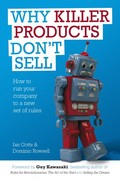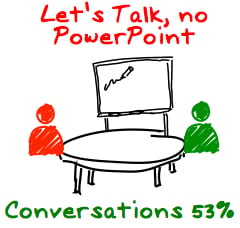What is Value-created selling and why does it matter?
To understand Value-created selling we need to examine the supplier-prospective customer interaction from both sides.
Buyer – the value created buying culture is used when the buyer has recognised they have a problem, an idea of where they want to be in the future and they have started to envisage various options to take them to that point on the horizon. The challenge for them is to understand the different levels of controllable and uncontrollable risk in the different options. With this being the situation they will call on vendors who can give them insight on unforeseen and critical risk. Solutions are not relevant at this stage.
Seller – they will be looking for issues creating change in the buyer’s world and by understanding the dynamics created by the change for the customer they will be able to create a vision of the future and to certain areas of risk in their response to the market conditions: by revealing these areas of risk to the customer and by showing where they can mitigate or migrate the risk they will initiate a Value Creation engagement.
In summary, Value-created selling is the approach taken to help a customer who has identified a problem or sub-optimal situation, to mentor and position a way forward where risks are unknown and there is no established buying category. In many cases the client will not be aware that a solution to its requirement exists; it takes the sellers view of the market, thought-leadership and industry insight to create understanding of how the products could be used to solve the problem and to mentor the buyer through the internal approval process.
I hadn't heard of the term value-created selling until I read "Why Killer-products Don't Sell", by Ian Gotts and Dominic Rowsell. This book is a revelation for technology sales professionals and I have since incorporated their I-M-P-A-C-T buying process into the sales training and E-Learning courses we deliver. See my review of the book.
According to Dominic Rowsell, "you don't choose how you want to sell. The customer, or rather the maturity of the product in a marketplace, determines the buying culture at any point in time."
The technology Adoption Lifecycle/Risk animation is excerpted from AMC's "Selling in the Internet Age" Salescraft Process eLearning Program.
Why is it important? Because in order to achieve success selling innovative products in the market the seller must adapt their sales process at each transition of the Technology Adoption Life-cycle to effectively match the way companies buy.
The great majority of sales professionals selling technology in the B2B space today operate in value-added or value-offered modes. Here, buyers know what they want, have established buying procedures and a formal process to compare, evaluate and acquire products/services, including industry analyst briefings and product rankings from various sources and recommendations from colleagues. There is nothing wrong these selling modes, provided they are in sync with the buyer, it's just that corporations and salespeople who sell this way will not be effective in selling into the early market until they are retrained and develop value-created selling skills and adapt their business models accordingly.
As a sales trainer, having observed hundreds of sales role-plays with sales people in all stages in their careers in the past 5 years, I have seen less than 10 sales-people who are really good at engaging the buyer in a "conversation of possibilities". If your company is selling technology products into a market that is still forming, then your sales team will function best if they acted like consultants....not fast-talking sales people. Time for training?
If you are an early stage company, how do you know there is a problem?
- In value-created sales there will be little competition yet big deals won't come through,
- Pilots will not convert to meaninful deals,
- Salespeople get an initial meeting, but no second meeting,
- Salespeople are talking to weak mentors who are not decision-makers and sales are stalled,
- Salespeople talk a lot about their products in meetings and fail to listen to the information the buyer is imparting,
- Salespeople use trial-close techniques, which perplex the buyer who is trying to sort out a problem and is not ready or able to buy.
What can be done to improve the success in selling to the early market?
1. Get marketing and sales aligned with the value-created selling process and clearly identify the Buyer Persona and how the products specifically create value for the persona.
2. Adopt an Inbound Marketing approach to get-found on the Internet, create mind-share, and incubate interested prospects
3. Equip your sales team with appropriate communication, language and listening skills - in an emerging market, the buyers may know there is a problem, but may not be able to clearly articulate how to go about solving it.
4. Develop a Whiteboard Selling story, capturing your value proposition and how buyers can use your products to create value and train all your customer facing reps in delivering it.
5. Align the operations of the company to support the new value-created selling mode.




